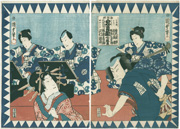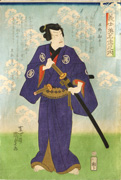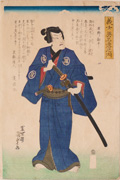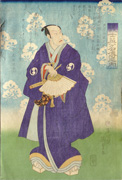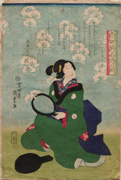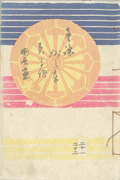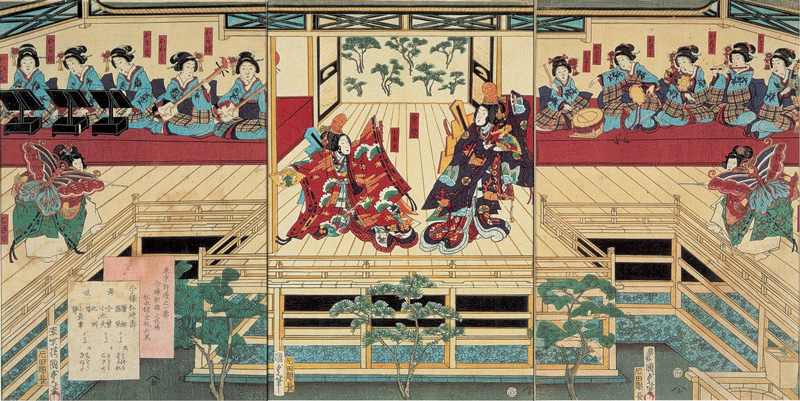Prints in Collection
Biographical Data
Profile
Utagawa Kunisada II 二代 歌川国貞 (1823-1880)Source: Museum of Cultural History Collections, Oslo, Norway http://www.khm.uio.no/utstillinger2/flytende_verden/english/samlinger_khm_utagawa_kunisada_II.html and Japanese Woodblock Prints: Artists, Publishers and Masterworks 1680-1900, Andreas Marks, Tuttle Publishing, 2010, p. 150.
Kunisada II was a disciple of the highly influential Utagawa School, and as such, took the name of his teacher, Utagawa Kunisada I (1786–1865). He later adopted the name of Toyokuni, the school’s founder, and thus became Toyokuni IV. He often found his motifs in the kabuki theater, pleasure quarters and tea-houses. After Japanese printmaking was introduced in Europe in the late 1860s, his works caught the attention of a Western public.
Van Gogh's Japonisme and the Critics' Bias
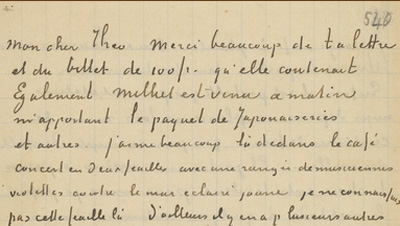
To Theo van Gogh. Arles, Friday, 21 September 1888.
Van Gogh Museum Amsterdam
http://vangoghletters.org/vg/letters/let685/letter.html
Van Gogh Museum Amsterdam
http://vangoghletters.org/vg/letters/let685/letter.html
My dear Theo
Many thanks for your letter and for the 100-franc note it contained. Milliet came this morning too, bringing me the parcel of Japanese prints and others. Among them I love the café-concert on two sheets, with a line of purple female musicians against the yellow-lit wall [see below]. I didn’t know that sheet, what’s more there are several others that were unknown to me…
I think I’ll put the Japanese prints downstairs in the studio.
Handshake.
Ever yours,
Vincent
Vincent Van Gogh's above referenced "cafe-concert"
The Matsumotorō theatre in the Tokyo pleasure district (Tōkyō Matsumotorō)
by Utagawa Kunisada II, 1870
The Matsumotorō theatre in the Tokyo pleasure district (Tōkyō Matsumotorō)
by Utagawa Kunisada II, 1870
While Van Gogh may have loved Kunisada II's prints, European critics, up until fairly recently, felt otherwise. Writing in 1917 in his seminal work Chats on Japanese Prints, Arthur Davison Ficke wrote:
| His prints, largely executed in cheap analine colours, set one's teeth on edge with some of the most shrieking discords that I have ever encountered. There exists an unfortunate collector who proudly brought back from Japan one hundred and nineteen triptychs by this artist.1 |
1 Chats on Japanese Prints, Arthur Davison Ficke, Frederick A. Stokes Company, 1917, p. 352.
2 A Dictionary of Japanese Artists: Painting, Sculpture, Ceramics, Prints, Lacquer, Laurance P. Roberts, Weatherhill, 1976, p. 97.
Biography
Sources: Japanese Woodblock Prints: Artists, Publishers and Masterworks 1680-1900, Andreas Marks, Tuttle Publishing, 2010, p. 150 and A Dictionary of Japanese Artists: Painting, Sculpture, Ceramics, Prints, Lacquer, Laurance P. Roberts, Weatherhill, 1976, p. 97.Family name: Takenouchi 竹内. Given name: Munehisa 宗久. Art surname: Utagawa 歌川. Artist names: Kunimasa III 国政 三代, Kunisada II 国定 二代 from 1851; Toyokuni IV 豊国四 代from 1870. Art names (gō): Baidō 梅堂, Hōraisha 宝来舎, Ichijusai (c.1844-54) 一寿斎, Ichiyōsai 一陽斎, Baichōrō (c. 1852-1870) 梅蝶楼, Kōchōrō 香蝶楼.
Not many details are known about Kunisada II who was born in 1823. He became a student of Kunisada and signed his earlierst works as Kunimasa (III). Kunisada’s II’s earliest known prints date to 1844. In 1846, Kunisada adopted Kunisada II after he married his oldest daughter Osuzu. The name change from Kunimasa III to Kunisada II occurred in late 1850 or early 1851, at about the same time when Kunisada bequeathed his house in Kameido to Kunisada II.
Kunisada II continued in the style of Kunisada, but never reached the level of success that his teacher did. He mostly designed actor prints but was also active in other subjects like beautiful women, Genji prints, or erotica, sometimes in collaboration with other artists.
With nearly 200 different titles, Kunisada II was a prolific book illustrator. Just over forty print series by him are known. He worked for almost fifty publishers, in particular Tsutaya Kichikzō. The popularity of his work decreased dramatically in the early Meiji period. He continued as head of the Utagawa School with a few students such as Kunisada III (Utagawa Kunimasa IV 1848-1920) and changed his name in late 1870, again like his teacher Kunisada did before him, calling himself now Toyokuni (IV). However, he designed only few prints or illustrated books in the 1870s and seems to have stopped completely after 1874.
Age 58, Kunisada II passed away on July 20, 1880. His posthumous Buddhist name is Sankōin Hōkokujutei Shinji and, like Toyokuni and Kunisada, he is buried at the Banshōin Kōunji.1
1 Banshoin Kounji Temple in Kami-Takada (in present-day Tokyo's Nakano Ward).
Kunisada II's Memorial Portrait of Kunisada I
Memorial Portrait of Utagawa Kunisada I (Kôchôrô Toyokuni shôzô)
Utagawa Kunisada II signed Kôshi (loyal son) Kunisada sha
1864, 12th month
Museum of Fine Arts, Boston 53.450
Utagawa Kunisada II signed Kôshi (loyal son) Kunisada sha
1864, 12th month
Museum of Fine Arts, Boston 53.450
Artist's Signatures
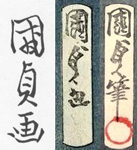 |  |  |  |
 |  |  | -Kunisada-sh-aa2678b9a03a7fa7.jpg) |




